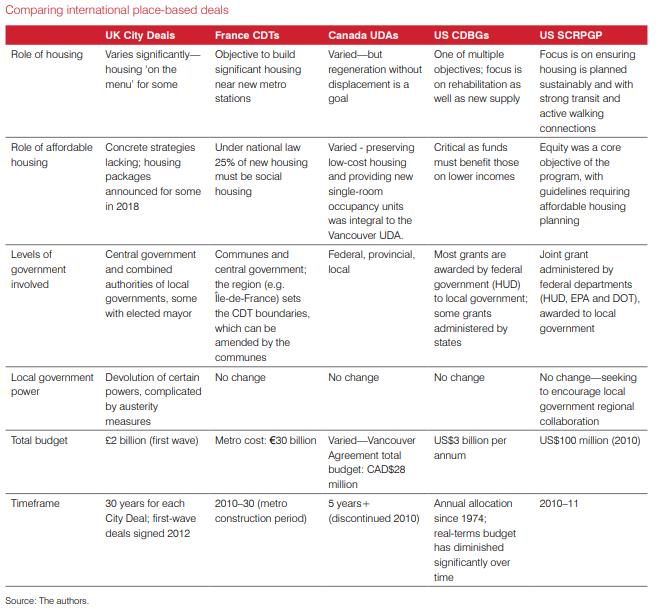
Success of city deals requires explicit support for affordable housing: report
City deals and regional strategic plans need specific strategies to ensure there is not a mismatch between the location of jobs and affordable housing for low income workers
22 Jul 2020
Australian cities show a growing mismatch between the locations of employment and the geography of affordable rental housing. Low-income workers, who play a critical role in urban labour markets, are finding it increasingly difficult to access affordable rental housing near major employment centres.
In the latest AHURI research report, ‘Strategic planning, ‘city deals’ and affordable housing’, researchers from the University of Sydney examine the issues with place-based planning and funding interventions, both locally and overseas in delivering affordable rental housing.
The report finds that City Deals and similar place-based funding programs can help kickstart new economic opportunities in areas, but they need explicit support for affordable housing if lower income workers are to find homes close to employment opportunities.
‘In areas which are affordable but don’t have lots of jobs, infrastructure investment can help connect households with employment. However... policies to support diverse housing, including rental housing, need to be considered in conjunction with infrastructure investment.
In both Sydney and Melbourne, there remains a mismatch between the location of jobs and affordable housing for low income workers, and in both cities affordable rental housing is more prevalent in areas that are not currently serviced by passenger rail networks. In Greater Sydney, affordable rents are found predominantly in outer suburbs generally more than 50 kilometres from the job-rich CBD suburbs.
‘City deals and regional strategic plans need specific strategies to ensure that rental accommodation remains affordable and available to low income households,’ says Professor Nicole Gurran from the University of Sydney. ‘Our analysis points to the need for different types of interventions to address housing affordability and job accessibility in different localities. ‘In areas that are job and transport rich, and where median market rents significantly exceed affordable levels by more than 20 per cent, rental housing affordable to lower income households is only likely to be delivered as a result of statutory planning policies and funding programs that support the development of affordable housing for which eligibility is restricted to target households.’
‘In areas which are affordable but don’t have lots of jobs, infrastructure investment can help connect households with employment. However, as outer suburban areas may have affordable median rents but not necessarily a significant supply of rental housing, policies to support diverse housing, including rental housing, need to be considered in conjunction with infrastructure investment. In addition, affordability may not be preserved over the long term without strategies and policies to support it.’
‘These satellite cities often have high car dependency and there is a risk that new residential areas will be poorly served by public transport, undermining affordable living objectives.’
The report also looked at the role satellite cities, such as Geelong in Victoria and Wollongong in New South Wales, can play in offering affordable rental accommodation. These satellite cities are linked to Sydney and Melbourne by high-quality transport connections and can provide affordable rental housing opportunities, but there is a paradox in that the government strategies designed to improve connectivity to capital city employment centres are also seeking to attract and retain a labour market to live and work in the local area.
The report found that strategies in satellite cities like Geelong and Wollongong need to support local job growth while preserving affordable rental supply and providing a spectrum of other housing choices.
‘It is important that housing growth in these smaller cities is balanced by local employment and transport opportunities to ensure that lower income working households are not forced to commute long distances to major cities,’ says Professor Gurran.
‘These satellite cities often have high car dependency and there is a risk that new residential areas will be poorly served by public transport, undermining affordable living objectives.’
This study also examined international experience in developing and implementing place-based deals across North America, Europe, and the UK. Internationally, and increasingly in Australia, strategic funding interventions such as city deals have emerged as targeted place-based models for catalysing economic development through investment and infrastructure supporting jobs, housing and connectivity.

The researchers will present their findings on 5 August in the AHURI Research Webinar, Connecting affordable housing and jobs in Australian cities. The 90 minute webinar will explore how place-based deals in Australia can be leveraged to enhance urban and regional productivity by improving the links between jobs, transport and affordable rental housing; international examples of place-based deals and funding interventions from the US, UK, Canada and France; and the role satellite cities such as Geelong (Victoria) and Wollongong (NSW) can play in addressing growth and affordability pressures in Melbourne and Sydney.
The report can be downloaded from the AHURI website at http://www.ahuri.edu.au/research/final-reports/331
